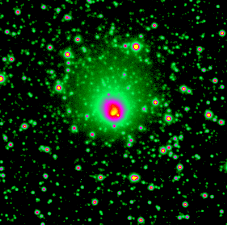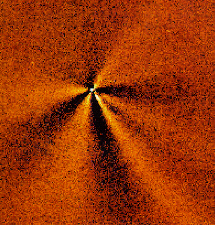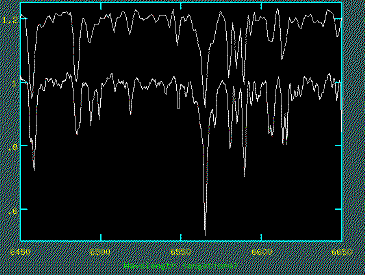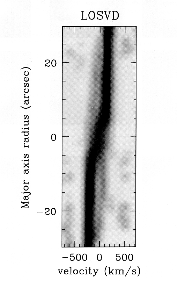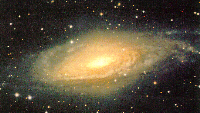 | |||
|
| Home > Public Information > Scientific Highlights > 1996 |
|
in 1996* |
[ SOLAR SYSTEM | STARS | GALAXIES | OBSERVATIONAL COSMOLOGY ]
|
|
|
|
|
| More
information
ING facilities involved:
|
|
|
|||
|
|||
| More
information
ING facilities involved:
|
A GRAVITATIONALLY LENSED Z=2.515 STAR-FORMING
GALAXY
The origin and evolution of galaxies
is one of the holy grails of modern astronomy. It is interesting that despite
a huge effort over the last few decades, the nature of galaxy evolution
is still much less well understood than that of the stars from which the
galaxies themselves are largely made. In order to study how galaxies change
with time, the astronomer must isolate populations at different look-back
times and compare them with the well-studied objects we see around us today.
The major problem of this work is that the farther away you look, the fainter
the sources become, and consequently isolating such a population from bright,
close-by objects becomes very difficult.
The most obvious and systematic method is to conduct large spectroscopic surveys to determine redshifts for as many faint galaxies as possible. The disadvantage of this approach is that even at the faint limits achievable with 10m telescopes, only a tiny fraction of galaxies lies beyond about a redshift of 1. Thus a huge number of redshifts must be accumulated before even one distant source is located. What is needed is a method of selection which would only be sensitive to very distant galaxies. One of these methods is based on gravitational lensing by clusters of galaxies, in which the selection is purely geometrical.
Giant arcs in clusters were first recognised in the mid-1980s and the great potential of lensing as a cosmological tool was realised soon afterwards. The magnification and distorsion induced by the lensing depends solely on the position and distance of the source with respect to the lensing cluster. Thus low-luminosity sources may be magnified just as often as high luminosity ones by virtue of their alignment with the lens. The magnification allows the astronomers to obtain spectra and redshifts for objects otherwise too faint for such study with today's telescopes. Moreover, in addition to the boosting of the apparent magnitude, the lensing spatially magnifies the objects, whose components may then be studied individually. A second advantage of this technique is its ability to amplify sources over a wide redshift range (z>0.5).
Data from the HST enables the construction of very precise mass models for selected lensing clusters. A good example is the recent analysis of Abell 2218 (z=0.175), where the resolution of the HST allowed the construction of a detailed mass model constrained by as many as seven multiply-imaged sources. Based on these mass models, a number of the arclets were predicted to have redshifts z>1.
As part of a major effort to verify the lensing inversion method for Abell 2218, astronomers secured spectra for a large sample of faint arclets. For this purpose, the Low Dispersion Survey Spectrograph (LDSS-2) at the WHT was used. As a result, a redshift of z=2.515 for a refracted galaxy was obtained and this was the first confirmation of a redshift predicted by a cluster lensing model.
The source responsible for the lensed
images appeared to be a blue galaxy whose on-going star formation rate
of 7–11 solar masses per year is similar to that of similar sources found
at higher redshift using the Lyman limit cutoff as a high-z locator. Its
brightness was magnified almost 3 magnitudes thanks to the lensing process.
| More
information
ING facilities involved:
|
DWARF IRREGULAR GALAXIES ARE OLD SYSTEMS
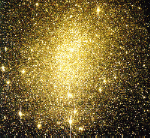 A
large old to intermediate-age stellar population has been found in a couple
of dwarf irregular (dIr) galaxies in the Local Group. The blue colours
of dIr galaxies, their large numbers of HII regions, Ha flux, blue stars
and relatively large amount of gas have led them to be referred to as young
objects and to be preferred targets for the study of young stellar populations
and recent star formation. The presence and the age of a stellar population
older than a few thousands of millions of years in dIrs had been questioned,
even though an underlying population of red stars has been detected in
the nearest of them (often called Baade's sheet). But the presence of Baade's
sheet is not, by itself, a proof of old age since it may be produced by
stars just a few thousands of millions of years old.
A
large old to intermediate-age stellar population has been found in a couple
of dwarf irregular (dIr) galaxies in the Local Group. The blue colours
of dIr galaxies, their large numbers of HII regions, Ha flux, blue stars
and relatively large amount of gas have led them to be referred to as young
objects and to be preferred targets for the study of young stellar populations
and recent star formation. The presence and the age of a stellar population
older than a few thousands of millions of years in dIrs had been questioned,
even though an underlying population of red stars has been detected in
the nearest of them (often called Baade's sheet). But the presence of Baade's
sheet is not, by itself, a proof of old age since it may be produced by
stars just a few thousands of millions of years old.
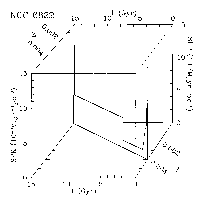 Following
a new approach to the problem (based on the comparison of observedand model
colour-magnitude [CM] diagrams), star formation histories (SFHs) for old,
intermediate and young ages have been obtained on the INT for three dIr
galaxies: NGC6822, Pegasus and LGS3. Model CM diagrams are built up for
different input SFHs and an accurate simulation of observational effects
is a majoringredient. Although the resolution worsens in the determination
of the SFH as we go to older ages, this work gives a definite answer to
the question of the age of these dIrs in the sense that not only dIrs they
begin to form stars about 15,000 million years ago but also that they show
SFHs enhanced in the first half of their lives.
Following
a new approach to the problem (based on the comparison of observedand model
colour-magnitude [CM] diagrams), star formation histories (SFHs) for old,
intermediate and young ages have been obtained on the INT for three dIr
galaxies: NGC6822, Pegasus and LGS3. Model CM diagrams are built up for
different input SFHs and an accurate simulation of observational effects
is a majoringredient. Although the resolution worsens in the determination
of the SFH as we go to older ages, this work gives a definite answer to
the question of the age of these dIrs in the sense that not only dIrs they
begin to form stars about 15,000 million years ago but also that they show
SFHs enhanced in the first half of their lives.
This result is a new step towards the
understanding of the mechanisms of the
formation and evolution of galaxies.
The dIrs seem now to be as old as the other
kind of dwarf galaxies, the dwarf ellipticals
(dE), which show few or no traces of
recent star formation but which might
have a stronger relationship with dIrs than is usually assumed.
| More
information
ING facilities involved:
|
|
|
|
|
|
| More
information
ING facilities involved:
|

